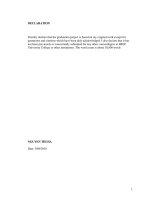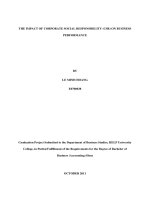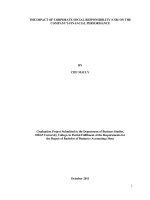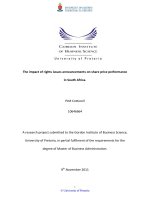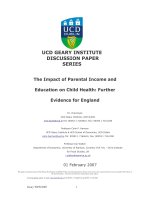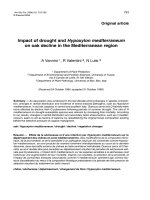LV thạc sỹ_The impact of non profit health insurance on treatment seeking behavior
Bạn đang xem bản rút gọn của tài liệu. Xem và tải ngay bản đầy đủ của tài liệu tại đây (2.57 MB, 81 trang )
NATIONAL ECONOMICS
UNIVERSITY
HANOI
INSTITUTE OF SOCIAL STUDIES
THE HAGUE
VIETNAM-NEITHERLANDS CENTER
FOR DEVELOPMENT ECONOMICS AND PUBLIC POLICY
The impact of non-profit health insurance
on treatment seeking behavior:
The case of vietnam
(VHLSS 2006)
A thesis presented by
In partial Fulfillment of the Requirement for
Obtaining the Degree of Master of Arts in Development Economics
Supervisor: Prof..
HANOI
2
DECLARATION
I hereby certify that this thesis has used materials that has been accepted
or with out copied of any other degrees or diplomas at any other academic
institutions. By learning and my knowledge, the thesis contains no sources
and materials previously published or written by other persons, except the
references listed.
Hanoi, June 2011
3
ACKNOWLEDGEMENT
By completing the thesis, I would like to express my gratitude to people
who gave me a great support and assistance to complete this thesis.
First of all, I would sincerely express to thanks my suppervisor, Prof. Dr.
…
Finally, I would sincerely express to thanks my family and specially from
my wife who gave me an encouragement and a contritbution of finance
during my study.
…
4
ABSTRACT
In Vietnam, there are some studies on health care services and it gives out
some significant ruslts of influence on policy makers. However, these studies
still have some limitations due to data as well as information updates.
By using very rich date set from the Vietnam Household Living
Standards Surveys 2006 (VHLSS 2006), the thesis has explicitly estimated
the effect of health insurance on utilization of all types of health care services
and providing detailed information on both of individual health and
household status and the type of provider sought covering all provinces.
Beside, the thesis also estimated the impact of health insurance on health care
utilization by the poor. In addtion, by the stusdy period covered 12 months,
the thesis is better capture seasonal effects as well as other time- related
dimensions of health treatment behaviors within a year. Findings of the thesis
has been suggested that individuals are propensity to visiting or admission to
health facilitaties, specially for public health facilitation and the insured is no
effect on the frequency of outpatient visit to public providers. Deeply, the
result of thesis showed that the groups of health insurance/free health card for
the poor and children under 6 YOs is commune clinics and the group of
compulsory health insurance mainly visited public polyclinics, district
hospital or higher level of public health facilities.
5
TABLE OF CONTENTS
DECLARATION....................................................................................................2
ACKNOWLEDGEMENT.....................................................................................3
ABSTRACT............................................................................................................4
LIST OF ABBREVIATIONS.................................................................................7
LIST OF TABLES..................................................................................................8
LIST OF FIGURES................................................................................................9
CHAPTER I..........................................................................................................10
1. Introduction:............................................................................................10
2. Research questions..................................................................................13
3. Objectives and scope of the study:..........................................................13
4. Data and Methodology:...........................................................................14
5. Structure of the thesis..............................................................................15
CHAPTER II: LITERATURE REVIEW..................................................16
1. Literature review in general....................................................................16
2. Studies of utilization on healthcare in Vietnam.......................................18
CHAPTER III: HEALTH CARE SYSTEM AND HEALTH UTILIZATION
IN VIETNAM.......................................................................................................21
1. Introduction of healthcare system in Vietnam.........................................21
1.1. Public health care system..................................................................21
1.2. Private health care system................................................................22
2. Health care utilization.............................................................................24
2.1. No treatment and self-medication.....................................................24
2.2. Inpatient services..............................................................................25
2.3. Outpatient services utilization...........................................................26
2.4. The schemes of health insurance in Vietnam....................................27
2.5. Heath care for the poor.....................................................................28
CHAPTER IV: METHODOLOGY AND EMPIRICAL RESULT..........30
1. Methodology and data.............................................................................30
1.1. Methodology......................................................................................30
1.1.1 Logit model................................................................................30
6
1.1.2 Count regression models...........................................................31
1.2. Model selection.................................................................................33
1.3. Data...................................................................................................33
2. Variable description.................................................................................34
3. Descriptive analysis.................................................................................72
4. Econometric results.................................................................................76
CHAPTER V: FINDINGS AND POLICY IMPLICATIONS..................83
CHAPTER VI: CONCLUSION..................................................................84
REFERENCES..............................................................................................87
7
LIST OF ABBREVIATIONS
CHI
: Compulsory Health Insurance
CHS
: Commune Health Station
DHO
: District Health Office
DPC
: District People’s Committee
GSO
: General Statistics Office
HCFP
: Health Care Fund for the Poor
JHUES
: Healthcare Utilization and Expenditure Survey
JHUES
: Jordan Healthcare Utilization and Expenditure Survey
MOH
: Ministry of Heath
OOP
: out-of-pocket
PHD
: Provincial Health Department
PPC
: Provincial People’s Committee
VHI
: Voluntary Health Insurance
VHLSS
: Vietnam Household Living Standards Surveys
8
LIST OF TABLES
Table 1: Health insurance coverage by expenditure quintiles........................35
Table 2: The use of outpatient care across providers by the insurance status
and the type of insurance...............................................................................36
Table 3: Decomposition of utilization by health facilities, inpatients............37
Table 4: Number of outpatient contacts per person........................................38
Table 5: Number of inpatient contacts per person..........................................39
Table 6: Probability of health facilities contacts in general Odd ratio...........40
Table 7: The results for contacts and frequency of outpatient contacts at the
commune health centres.................................................................................48
Table 8: Probability of out-patient contacts and Frequencies of contacts:
public polyclinics/hospitals............................................................................56
Table 9: Probability of out-patient contacts and Frequency of contacts:
Private clinics/hospitals..................................................................................61
Table 10: Probability of in-patient contacts and frequency of contacts: public
polyclinics/hospitals.......................................................................................66
9
LIST OF FIGURES
Firgue 1: Distribution of inpaatient contacts across healthfacilities by rural
and urban population......................................................................................25
Figure 2: Health insurance coverage by expenditure quintiles......................72
Figure3: Percentage of health contacts of different groups of health
insurances.......................................................................................................73
10
CHAPTER I
1. Introduction:
In recent years, Vietnam has been encouraging and strengthening the
explicit role of insurance in health system. To achieve the “Millennium
Development Goals”, the social care services need to be extended and
improved. Health insurance is a kind of socialized project which helps share
the financial burden of illness between the Government and the population.
The insurance coverage was introduced in 1992 in Vietnam, the scheme was
initially compulsory, then later extended to include a voluntary scheme and a
free health-card scheme for the poor was also initiated afterwards. The
Compulsory Health Insurance (CHI) scheme includes current and retired civil
servants and the employees of state enterprises as well as those in large
private enterprises with more than ten employees, employees of foreign
owned enterprises and organization, the scheme covers the cost of inpatient
and outpatient treatment at hospitals, subject to some ceilings. The Voluntary
Health Insurance (VHI) scheme is in principle open to all those not eligible
for coverage under the CHI scheme, including the self-employed, employees
of small enterprises, family members of the insured and government
employees at or below the district level. Currently, the VHI scheme is open to
all community groups provided that minimum community thresholds are met,
including 20 percent of households in a commune or ward and 30 percent of
students in a given school (Nguyen & Akal, 2003). Although, Giang (2006)
gave an evidence that many provinces of Vietnam have been reluctant to
encourage voluntary insurance scheme, partly due to high cost resulting from
adverse selection and Jowett (2004) reviewed that Vietnamese Governmentorganized voluntary schemes may also be crowded by informal risk-sharing
networks. Besides, ever since 2002 there has been a health insurance scheme
implemented for the poor in Vietnam which covers residents of communes
11
with very difficult socio-economic status and ethnic minorities in
disadvantaged provinces of Vietnam. The scheme is funded by a variety of
charity and donor organizations and the Government through a poverty
alleviation program. On the other hand, the scheme has been also reorganized and funded more adequately under a national program according to
which provinces and centrally-run cities are instructed to establish Health
Care Funds for the Poor (Sepehri, Simpson & Sarma, 2006).
s. In term of theory, health insurance may affect health care utilization
and treatment-seeking behaviors in some manners. Firstly, it may reduce the
price of health care at the time of purchasing, so that it helps the insured
individuals have increasing access to health care services. In this aspect the
thesis will examine the individuals’ tendencies in using health care services
that are propensity to visiting or admission to health facilitaties in general.
Secondly, health insurance can probably help the insured reduce health care
expenditure through a risk-sharing and cost-pooling mechanism. Since one of
the insured’s expectations is to reduce costs of health care when being
insured, health insurance may affect their choices as to the type and place of
health care services as compared to when not being insured. This is especially
true for the poor when high cost of health care incurred could lead to their
health care catastrophe. In this dimension, we examine probability of
visiting/admission different types of health facilities as well as frequencies of
visiting/admission of those types. Thirdly, besides the influence of health
insurance on treatment-seeking behaviors of the insured, other socioeconomic factors could also affect the insured’s choices to a different extent.
For example, education -could partially determine people’s awareness of
health status- can be considered an important factor affecting the insured’s
treatment seeking behavior and therefore this thesis will clarify their impacts
and specifically correlation with the factor of being insured under the three
named insurance schemes.
12
Several studies have examined the influence of health insurance on the
utilization of health services including papers written by Jowett (2004),
Tridevi (2002) and Giang (2006). However, all those studies remain subject
to some limitations due to lack of comprehensive data or too strong
assumptions, which could lead to biases when applying into the recent
situation of the health insurance sector. In order that this thesis can fill in the
knowledge gap left by the afore-mentioned studies, the thesis examines the
impact of Vietnamese health insurance on treatment seeking behaviors of the
insured, with a further focus on those of the insured under the health
insurance for the poor scheme, which is a point of high significance and
practical interest.. Furthermore, by taking advantage of VHLSS 2006 dataset
and rich references, the thesis will be extended to study some more new
aspects. Firstly, the VHLSS 2006 allows us to explicitly estimate the effect of
health insurance on utilization of all types of health care services. The
analyses of insurance types allow us to test for their differences, if any, on
pattern of utilization and it also allows us to test probability of selection for
treatment seeking behaviors. Secondly, the VHLSS 2006 is more
comprehensive providing detailed information on both of individual health
and household status and the type of provider sought covering all provinces.
We are also able to estimate the impact of health insurance on health care
utilization by the poor. Thirdly, the study period cover 12 months especially it
is the first for outpatient contact which are believed to better capture seasonal
effects as well as other time- related dimensions of health treatment behaviors
within a year. Findings of the thesis will be given out for researchers and
policy makers who should be interested in finding solutions to the problems
and challenges arisen from the targeted universalization of coverage among
the whole population by the year of 2015, as set out by the Vietnamese
Government.
13
2. Research questions
* Central question: What is the impact of health insurance on the treatmentseeking behavior.
* Sub-questions:
+ How does health insurance (and its separate components) affect the
usage of public health care services by the insured?
+ How does health insurance (and its separate components) affect the
usage of private health care services by the insured?
+ How does health insurance (and its separate components) affect the
usage of outpatient health care services by the insured?
+ How does health insurance (and its separate components) affect the
usage of inpatient health care services by the insured?
Hypothesis:
+ Insured individuals tend to use more public health care services than
private health care services when feeling ill.
+ Health insurance increases the probability of using public health care
services, especially those with low income status.
+ Being insured under Health Care Fund for the Poor increases the
probability of insured individuals seeking health care services at public
providers.
3. Objectives and scope of the study:
- Objectives:
The study has three main goals as follows: (i) it will provide some
background information on health insurance and a discriptive analysis of data
(ii) It presents empirical analysis of the impact of health insurance schemes,
with focus on the health insurance for the poor, on the treatment seeking
behaviors of the insured over 12-month period which are believed to capture
seasonal health status and treatment behavior as well as other seasonal related
factors; and (iii) The thesis provide some policy recommendations.
14
- Scope of the Study:
The thesis uses the rich and most updated dataset of Vietnam Households
and Living Standards Survey (VHLSS 2006) to estimate the impact of
different health insurance schemes over 12-month period. Firstly, the
probabilities of outpatient contracts and inpatient admission in general are
investigated. Secondly, it will examine of health treatment seeking behaviors
for specific types of health facilities- public health facility, government
polyclinic/ hospital, and private clinic/hospital.
4. Data and Methodology:
a. Data:
The study uses the Vietnam Household Living Standards Surveys 2006
(VHLSS 2006) which is a very rich dataset collected from Vietnam in a
World Bank funded program and executed by the Vietnam General Statistics
Office (GSO). The dataset includes, among other things, full information on
different types of insurance, health care expenditure by the insured, types of
health care services as well as types of health care providers sought by the
insured when falling ill, and other socio-economic factors related to the
insured such as sex, age, health status, proximity to health care providers or
marital status.
In addition, the study also uses other data from the GSO and the Ministry
of Health as references to enrich the statistical analysis of the sector.
b. Model:
Appropriate models are selected to answer research questions. As probability
of contact or admission could be defined as a binary variable, the logit model
is used to study this theme. Meanwhile Count regression models for discrete
dependent variables are suitable for investigating density of contacts or
admission. Justification of model selection will be presented chapter IVmethodology and empirical results.
15
5. Structure of the thesis
The thesis will be presented in the following structure: Chapter I presents
problem statement, methodology, data, research questions as well as the
relevance of the study. Chapter II includes some literature reviews, a
summary of recent developments of the health care and health insurance
sectors of Vietnam. Chapter III will be introduced the health care system and
health utilization in Vietnam. Chapter IV presents methodology as well as
empirical results of the estimation models. A short description of the data and
information contained in the variables will be presented in this chapter.
Chapter V shows the findings and implications while Chapter VI gives out
conclusions to the thesis.
16
CHAPTER II
LITERATURE REVIEW
This chapter examines the recent studies on the utilization of health care
services in Vietnam among the insured patients. The focus is on the
methodology, data and findings in order to give a comparision with the
estimation results and findings which will be addressed in the later parts of
the thesis.
1. Literature review in general
There is a rich literature on the effect of health insurance on the pattern
of health service utilization all over the world. In developed countries,
previous studies show that health insurance has positive impact on the health
service utilization. Cameron et al. (1987) used household level data from
Australia Health Survey (1977-1978) and appropriate econometric models in
order to assess the determinants of health care utilization. Firstly, the paper
finds that utilization choices vary considerably across insurance types, but
that health status proves to be a stronger determinant of utilization of care
than for insurance choice. Secondly, the paper finds an evidence of both selfselection and moral hazard due to insurance for some health care types
(Cameron et al., 1987).. (luu y: Anh lam ro diem nay them nhe, kho hieu
qua).
As long as the studies of the same topic in middle-income countries are
concerned, Ekman (2007) examined the impact of health insurance on
outpatient utilization and expenditure. His study used rigorous quantitative
methods with household level data from Jordan to analyze the effect of
multiple health insurance availability in terms of utilization of outpatient
care, intensity of use, and individual out-of-pocket (OOP) spending on care.
Specifically, the study assesses whether insurance programs differ as to the
impact on utilization and spending, and if the impact vary across income
17
groups. The study used data from the Jordan Healthcare Utilization and
Expenditure Survey (JHUES) collected in 2000. The survey contained a
sample of 8,800 households and obtained information on each individual
within the household, the head of the household, and detailed health care
utilization and expenditure information on a randomly selected household
member. The study applied econometric techniques to a set of specified
models along the two-part model approach to the demand for health care. His
findings show that about 60 percent of the population is covered by some
types of insurance. However the distribution varies across income groups and
results of estimation showed that the effect of insurance on the outcome
indicators differ substantially across the various programs. He gave out the
conclusion that insurance is found to increase the intensity of utilization and
reduce out of pocket spending. However, no general insurance effect on the
probability of use is found (Ekman, 2007).
Sapelli and Vial (2001) studied the Self Selection and Moral Hazard in
Chilean Health Insurance. The authors used the data from the National
Socioeconomic Survey (1996) in Chile, According to the data, 60 percent of
the total population selected the public insurance National Health Fund
(FONASA), 25 percent of population selected private the health insurance
institution (ISAPRE) beneficiaries, and 11 percent have no insurance. The
remaining individuals are distributed among the Armed Forces and law
enforcement at 3 percent, and other groups that have special coverage
schemes. The model is based on the individual demand for health insurance
and health care services, taking the interdependence between these decisions
into account, within a framework of intertemporal utility maximization under
uncertainty. On the theoretical model, it gave the relationship between the
individual’s health insurance decisions and the consumption of health care,
the presence of self-selection bias must also be detected as the empirical
analysis is carried out. The empirical model explains the quantity of health
care services consumed. The paper showed that self selection with observable
18
risk variables, adverse selection against public, the probability of purchasing
health insurance is greater for families with higher income, young children,
larger household size, and more education; and when the household head is
older, female, and contributes to a Pension Saving Account. A higher income,
younger age, smaller number of dependents, residence in an urban area,
higher educational level, and employment with a larger company increase the
probability of choosing private insurance. The finding that older age and
more dependents positively affects affiliation to the public. Aspect of moral
hazard, the expected value of moral hazard on physician visits for
independent workers who purchase insurance is positive on average. The
estimated value indicates that, on average, insured workers consume more
than twice the quantity consumed by non insured workers. If we consider
private and public insurance beneficiaries separately, we find that moral
hazard is larger in the case of public insurance. This result is consistent with
the fact that independent workers who purchase public insurance have access
to almost complete coverage in physician visits, but in the private insurance
sector copayments are usually different from zero.
2. Studies of utilization on healthcare in Vietnam.
In Vietnam, there have been some but increasing studies on the effect of
health insurance on health care utilization. Jowett (2004) studied the effect of
being insured under the voluntary health insurance of Vietnam on pattern of
treatment seeking behavior, as the author used the data surveyed by the
Institute of Sociology in Hanoi which was limited itself to only 3 provinces
of Hai Phong, Ninh Binh and Dong Thap. A two-stage multinomial logit
model is used to tackle the problem of endogeneity, the results of the paper
have given out in both types of provider sought and type of cared in highly
significant empirical results. Because of the collected limitation data in 2004,
he only examined that the relation between the VHI and treatment seeking
behavior, health insurance status in his study is considered as an endogenous
19
and exogenous variable. The paper finds that health insurance was crowded
out by the compulsory scheme. Thanks to richer data sets, Trivedi (2002)
examines the patterns of health care utilization in Vietnam by analysing the
data sets of 1997-1998 VLSS. This paper compares utilization patterns
among the insured and the uninsured individuals and finds that insured
individuals, when ill, tend to seek treatment at commune health centers and
governmental hospitals rather than private health facilities and pharmacies
(Trivedi, 2002). In addition, the paper finds that the average difference in
government hospital utilization between the insured and uninsured is also
statically significant, that for the insured population being higher by a factor
of about 2.5 times, the average difference in the use of private health facility
and drug vendors is significantly higher for the uninsured sample than for the
insured (Trivedi, 2002). However, due to the structure of the data, the paper
fails to separate those insured under the voluntary component of the scheme,
from those enrolled compulsorily. Therefore, insurance status is considered as
exogenous. This can lead to biased estimation of the impact health insurance
on health care utilization if households with expected higher health
expenditure choose to enroll.
Similar to Tridevi (2002) and Jowett (2004), Giang (2006) studied on the
health insurance and pattern of health care utilization in the case of Vietnam.
By using the Vietnam National Health Survey data (VNHS 2001/2002), the
influence of health insurance under three different types is empirically
assessed. The paper showsthat the public providers, the insured have higher
probability of use and higher frequency of use of inpatient care than the
uninsured. The result also suggeststhat voluntary health insurance has no
effect on the frequency of outpatient visit to public providers (Giang 2002).
As for private providers, the findings gives out that the health insurance
diverts the use of health care services from private health providers to public
providers where the insurance benefits can be accessed. Therefore the paper
concludes that both compulsory insurance and health insurance for the poor
20
were found to have a negative influence on the probability and frequency of
having outpatient visits, however, voluntary health insurance has no influence
on probability and frequency of visits to private providers. However, due to
data limitation, Giang could analyze the impact of health insurance for the
poor or could not address the issue of possible adverse selection and assess
the factors influencing to the provider moral hazard.
Wagstaff (2007) used the VHLSS data in 2004 to analyze the initial
impact of the Health Care Fund for the Poor (HCFP). The data used for the
estimation covers 9,000 households and over 40,000 individuals and the
impact of HCFP is estimated by comparing out–of-pocket payment and
utilization between those covered by HCFP and comparable individuals not
covered. The paper used the method of propensity score matching which
measures the closeness of “treated” and “untreated” individual. Wagstaff
(2007) finds that there are both bad and good news in the program, the good
news is that program appears to be increasing the utilization of services quite
considerably and reducing the risk of catastrophic out of pocket spending.
The bad news
is three-fold. Firstly, there is no perceptible impact on
(average) out-of-pocket spending, and even with HCFP coverage poor
households are left spending a high share of their modest income on out-ofpocket health expenses and at considerable risk of catastrophic spending.
Secondly, the utilization impact is far more pronounced for inpatient care
than outpatient care. This may not necessarily be the most cost-effective way
of improving the health of poor Vietnamese households, and may leave them
facing including transport costs, informal payments, etc. that are higher than
necessary. Thirdly, the impacts on utilization are larger among the better off:
among the poorest deciles, utilization impacts are rarely significant
(Wagstaff, 2007).
21
CHAPTER III
HEALTH CARE SYSTEM AND HEALTH
UTILIZATION IN VIETNAM
The Chapter will give out information on health care system in Vietnam,
healthcare utilization for self-medicine, inpatient and outpatient services.
Beside, it is also resumed some different insurance schemes and health care
for the poor under Vietnam health insurance.
1. Introduction of healthcare system in Vietnam
1.1. Public health care system
In Vietnam, the health care system is organized by administrative level,
the Ministry of Heath (MOH) covers overall responsibility at the central
level. The MOH also directly controls 70 subordinate institutions in three
major areas, including: hospitals, preventive medicine and professional
institutes and pharmaceutical universities/schools (USAID 2009).
At the provincial level, every province has the Provincial Health
Department (PHD), a professional agency under the management of the
Provincial People’s Committee (PPC), works to advise the PPC on state
management of local people’s health care, protection and promotion, and
performs tasks and obligations as authorized by the PPC and standing
regulations. According to USAID, the PHD not only works under the control
of the PPC in terms of direction, organizational management, payroll and
operations, but is also under the control of the MOH in terms of technical
direction, guidance, monitoring and inspection. Under this PHD, there are a
number of provincial general hospitals and specialty hospitals, and provincial
preventive health centers.
At the district level, each district has the District Health Office (DHO), a
professional agency under the management of the District People’s
Committee (DPC), works to advise the DPC on state management of local
22
people’s health care, protection and promotion, and performs designated
tasks and obligations as authorized by the DPC and the PHD. Each district
also has a district hospital, and a district preventive center, and some
intercommunal polyclinics, majorities of these hospitals admit inpatients and
provide emergency care and basic treatment for common diseases (MOH
2000).
At the commune level, the Commune Health Station (CHS) is the first
formal point of health care contact in the government health care system, is
designated to provide primary health care services. They carry out early
detection of epidemics, provide care and treatment for common diseases and
deliveries, mobilize people to use birth control, practice preventive hygiene,
and carry out health promotion at the village level. The CHS has a
responsibility to the DHO and the Commune People’s Committee for local
people’s health care, protection and promotion, and receives technical
guidance from the district hospitals (USAID, 2009). It also was added by
USAID, the primary care facilities network is considered a grassroots level
network and covers all districts, and communes. By the end of 2006, Vietnam
had 671 districts and 10,876 communes/wards serving with health care
system.
1.2. Private health care system
The private health care system of Vietnam only officially started from
1989 when the government legalised to encourage multi-entities in the health
care services. Basically, by the end of 2006, there were 30,000 private clinics,
5 semi-public hospitals, 300 private regional general clinics and 87 maternity
wards throughout the country, this number is nearly increased at 20 percent in
comparision with 1996 while it was 25.698 private practitioners. In whole
country, there are 49 private hospitals including 36 general hospitals and 13
specialized hospitals with 4,050 sick beds. Although, the contribution of the
private health sector to the provision of health services, especially for
23
inpatient treatment, is very limited. In 2003, private health clinics provided
up to 60 percent of outpatient services, but only 4 percent of inpatient
services and about 10 percent of preventive health care services. Public
health facilities provided 40 percent of outpatient services, 96 percent of
inpatient services and 90 percent of preventive health care services (MOH
2003).
Currently, the private health sector has two tiers: the first tier consists of a
small but growing number of private hospitals. These hospitals are mainly
located in big cities. The second is private clinics which are located both in
urban areas and operate under full time or part time physicians (Giang 2006).
However, there is a serious imbalance in the distribution of private
practitioners, with a large concentration in urban areas with higher living
standards, there are also a large number of private practitioners without
licenses, and up to 70 percent of the total number of private clinics are run by
doctors who are also running the public health clinics. According to USAID,
there are only 26 percent of private clinics participate in primary health care
activities when mobilized. Most private consulting rooms violate regulations
that ban practitioners from selling drugs on their clinic premises. A
phenomenon often seen at private clinics is the overuse or inappropriate use
of drugs and advanced technologies, probably for financial benefit of the
practitioners.
In despite of
some above issues, the private health providers have
significantly contributed to health services such as more flexible opening
hours, more ready access, greater drug supplies and more respectful treatment
of clients. Moreover, total cost for treatment in private health services is
sometimes even less than in public health services due to the prevalence of
informal “envelope” payment in Vietnam (Giang 2006).
24
2. Health care utilization
The following section describes the healthcare utilization in Vietnam
from previous studies, in term of types of services sought, i.e., inpatient and
outpatient, no-treatment and self-medication. It also describes the use of
healthcare services by types of the schemes.
2.1. No treatment and self-medication
According to the VNHS 2002, among 66,795 cases who reported illness
in the 4 week reference period, only 4% of people did not receive any
treatment. Self-medication is the most popular choice of treatment in
Vietnam, accounting for 75% of those reported illness in the 4 week reference
period. Both VLSS 1998 and VNHS 2002 show consistent evidence of high
rate of self-medication among all age groups and levels of education. But
there is a big difference between ethnic groups: Kinh/Chinese have the
largest rate of self-medication: (73-74%) and the minorities in Central region
and Central high land have the lowest rare of 49%.
Comparing with other previous survey, VLSS (1993 and 1998), there has
been an increasing trend in rate of self-medication overtime. Using data of
VLSS 1998 Nguyen Thi Hong Ha (2002) found that the rate of selfmedication is about 70% compared to 75% in 2001-2002 (VNHS, 2002).
While in 1993, average annual services contacts to drugs vendors per capita
was 2.1, the number increased to 6.8 contacts by 1998. Contacts to drug
vendors account for two third of the total health contacts (World Bank, 2001).
There are many reasons for self-medication, including economic
difficulty, difficult access to health facilities, the use of old prescription, or
minor illness. According to VNHS, only 1% of the sample population reports
to self-medication owing to difficulty in accessing health facilities. The
economic difficulty cited as the main reason for self-medication by only 1%
of the richest quintile compared to 17% for the poorest quintile. Gertler and
Litvack (1998) conclude that the growth of self-medication is also a
25
consequence of the low quality of care available for the lower income groups.
Further, Trivedi (2002) states that freer availability of drugs and the
deregulation of over-the-counter sale of pharmaceuticals with active
ingredients have enhanced the practice of self-medication. There is a great
concern about the situation of antibiotic resistant bacteria, caused by the selfmedication practice.
2.2. Inpatient services
Firgue 1: Distribution of inpaatient contacts across
healthfacilities by rural and urban population
Source: Vietnam National Health Survey 2002 ( Giang 2006)
Inpatient services are mainly provided by government hospitals.
According to VNHS survey, the proportion of people seeking inpatient
services in period of 12 months prior to the survey is 5.4%. Figure 1 shows
visits to health facilities for inpatient services in period of 12 months prior to
VNHS 2002 survey. As the figure shows, the number of patients seeking for
inpatient care in private facilities is very low, accounting for 4%. However,
although the provision of inpatient care by private clinics/hospitals remain

